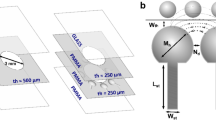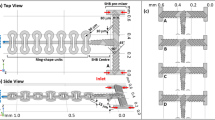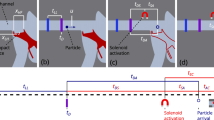Abstract
We use three-dimensional numerical simulations and experiments to examine microfluidic mixing induced by orbiting magnetic microbeads in a microfluidic channel. We show that orbiting microbeads can lead to rapid fluid mixing in low Reynolds number flow, and identify two distinct mixing mechanisms. Bulk advection of fluid across the channel occurs due to the flow pattern that is developed when the ratio of flow velocity to bead velocity is low, and leads to rapid mixing. At higher velocity ratios, dispersion of small amounts of fluid across the channel occurs and results in increased mixing. We use simulations to investigate the effect of system parameters on the distance required to achieve a desired mixing level. We develop an experimental continuous-flow device and use it to validate our simulations and to demonstrate rapid microfluidic mixing. This device has the flexibility to also be applied to a mixing chamber or to stop-flow applications for rapid and controllable mixing. In addition to rapid mixing, the use of orbiting magnetic microbeads has the added benefit that functionalized microbeads can be used to capture particles from the fluid solution during mixing, and that they can be extracted from the device for analysis, thus serving multiple functionalities in a single device.








Similar content being viewed by others
References
Ahmed D, Mao X, Juluri BK, Huang TJ (2009) A fast microfluidic mixer based on acoustically driven sidewall-trapped microbubbles. Microfluid Nanofluid 7:727–731
Alexeev A, Verberg R, Balazs AC (2005) Modeling the motion of microcapsules on compliant polymeric surfaces. Macromolecules 38:10244–10260
Alexeev A, Verberg R, Balazs AC (2006) Designing compliant substrates to regulate the motion of vesicles. Phys Rev Lett 96:148103
Ballard M, Mills ZG, Beckworth S, Alexeev A (2014) Enhancing nanoparticle deposition using actuated synthetic cilia. Microfluid Nanofluid 17:1–8
Bouzidi M, Firdaouss M, Lallemand P (2001) Momentum transfer of a Boltzmann-lattice fluid with boundaries. Phys Fluids 13:3452–3459
Dasgupta PK, Liu S (1994) Electroosmosis: a reliable fluid propulsion system for flow injection analysis. Anal Chem 66:1792–1798
Dendukuri D, Gu SS, Pregibon DC, Hatton TA, Doyle PS (2007) Stop-flow lithography in a microfluidic device. Lab Chip 7:818–828
Dittrich PS, Schwille P (2003) An integrated microfluidic system for reaction, high-sensitivity detection, and sorting of fluorescent cells and particles. Anal Chem 75:5767–5774
Fu AY, Chou H-P, Spence C, Arnold FH, Quake SR (2002) An integrated microfabricated cell sorter. Anal Chem 74:2451–2457
Furlani EP (2001) Permanent magnet and electromechanical devices: materials, analysis, and applications. Academic Press, New York
Furlani E (2006) Analysis of particle transport in a magnetophoretic microsystem. J Appl Phys 99:024912
Gijs MA, Fdr Lacharme, Lehmann U (2009) Microfluidic applications of magnetic particles for biological analysis and catalysis. Chem Rev 110:1518–1563
Harnett CK, Templeton J, Dunphy-Guzman KA, Senousy YM, Kanouff MP (2008) Model based design of a microfluidic mixer driven by induced charge electroosmosis. Lab Chip 8:565–572
Ladd AJC, Verberg R (2001) Lattice-Boltzmann simulations of particle-fluid suspensions. J Stat Phys 104:1191–1251
Lee C-Y, Chang C-L, Wang Y-N, Fu L-M (2011) Microfluidic mixing: a review. Int J Mol Sci 12:3263–3287
Liu RH et al (2000) Passive mixing in a three-dimensional serpentine microchannel. J Microelectromech Syst 9:190–197
Liu RH, Lenigk R, Druyor-Sanchez RL, Yang J, Grodzinski P (2003) Hybridization enhancement using cavitation microstreaming. Anal Chem 75:1911–1917
Lu L-H, Ryu KS, Liu C (2002) A magnetic microstirrer and array for microfluidic mixing. J Microelectromech Syst 11:462–469
Mao W, Peng Z, Hesketh PJ, Alexeev A (2011) Microfluidic mixing using an array of superparamagnetic beads. Bull Am Phys Soc 56
Marsaglia G, Tsang WW (2000) The ziggurat method for generating random variables. J Stat Softw 5:1–7
Mengeaud V, Josserand J, Girault HH (2002) Mixing processes in a zigzag microchannel: finite element simulations and optical study. Anal Chem 74:4279–4286
Nadim A, Cox R, Brenner H (1986) Taylor dispersion in concentrated suspensions of rotating cylinders. J Fluid Mech 164:185–215
Owen D, Mao W, Alexeev A, Cannon JL, Hesketh PJ (2013) Microbeads for sampling and mixing in a complex sample. Micromachines 4:103–115
Owen D, Ballard M, Alexeev A, Hesketh P (2016) Rapid microfluidic mixing via rotating magnetic microbeads. Sens Actuators A Phys (Under review)
Rida A, Gijs M (2004) Manipulation of self-assembled structures of magnetic beads for microfluidic mixing and assaying. Anal Chem 76:6239–6246
Rosensweig RE (1997) Ferrohydrodynamics. Dover Publications, Mineola
Schönfeld F, Hessel V, Hofmann C (2004) An optimised split-and-recombine micro-mixer with uniform ‘chaotic’ mixing. Lab Chip 4:65–69
Stroock AD, Dertinger SKW, Ajdari A, Mezic I, Stone HA, Whitesides GM (2002) Chaotic mixer for microchannels. Science 295:647–651
Succi S (2001) The lattice Boltzmann equation for fluid dynamics and beyond. Numerical mathematics and scientific computation. Numerical mathematics and scientific computation. Oxford University Press, Oxford
Tuckerman M, Berne BJ, Martyna GJ (1992) Reversible multiple time scale molecular-dynamics. J Chem Phys 97:1990–2001
van den Beld WT, Cadena NL, Bomer J, de Weerd EL, Abelmann L, van den Berg A, Eijkel JC (2015) Bidirectional microfluidic pumping using an array of magnetic Janus microspheres rotating around magnetic disks. Lab Chip 15:2872–2878
Verberg R, Alexeev A, Balazs AC (2006) Modeling the release of nanoparticles from mobile microcapsules. J Chem Phys 125:224712
Weigl BH, Bardell RL, Cabrera CR (2003) Lab-on-a-chip for drug development. Adv Drug Deliver Rev 55:349–377
Whitesides GM (2006) The origins and the future of microfluidics. Nature 442:368–373
Acknowledgments
Financial support from the National Science Foundation (CBET-1159726) and the US Department of Agriculture (2014-67017-21703) is gratefully acknowledged.
Author information
Authors and Affiliations
Corresponding author
Electronic supplementary material
Below is the link to the electronic supplementary material.
Rights and permissions
About this article
Cite this article
Ballard, M., Owen, D., Mills, Z.G. et al. Orbiting magnetic microbeads enable rapid microfluidic mixing. Microfluid Nanofluid 20, 88 (2016). https://doi.org/10.1007/s10404-016-1750-1
Received:
Accepted:
Published:
DOI: https://doi.org/10.1007/s10404-016-1750-1




